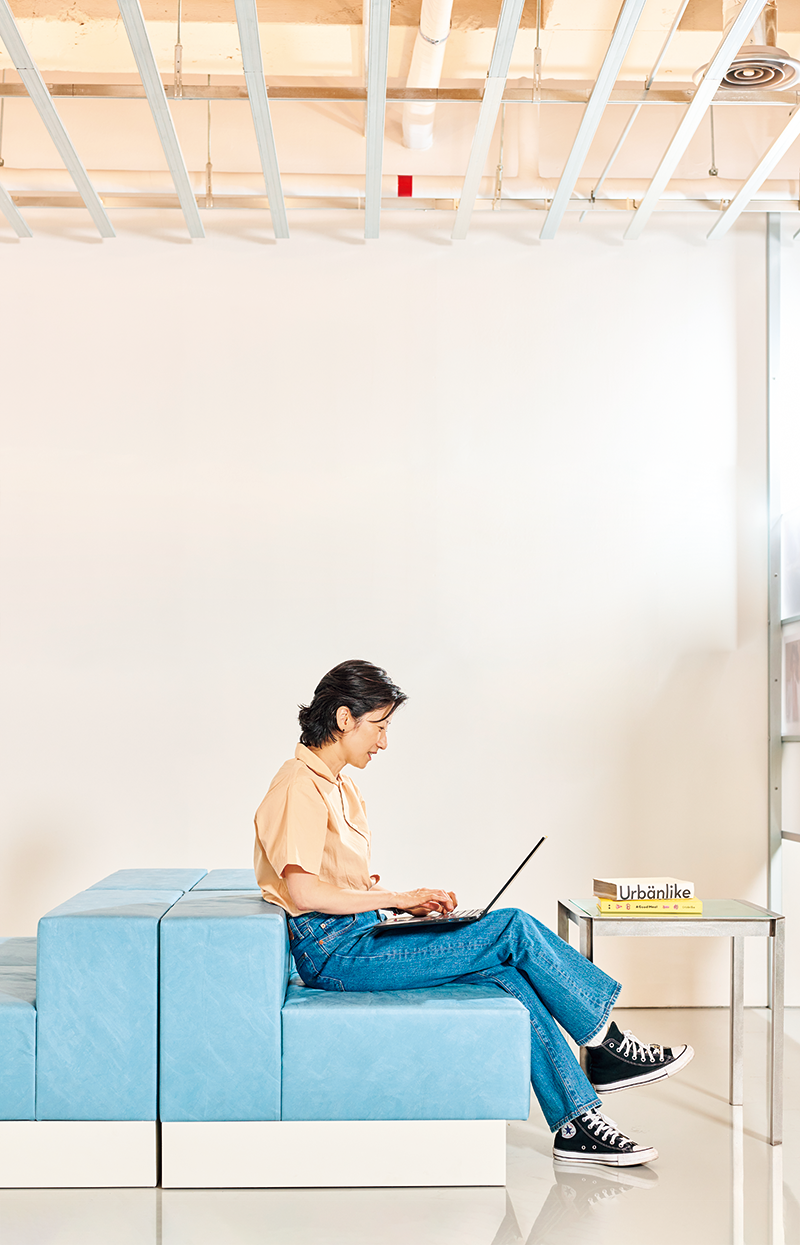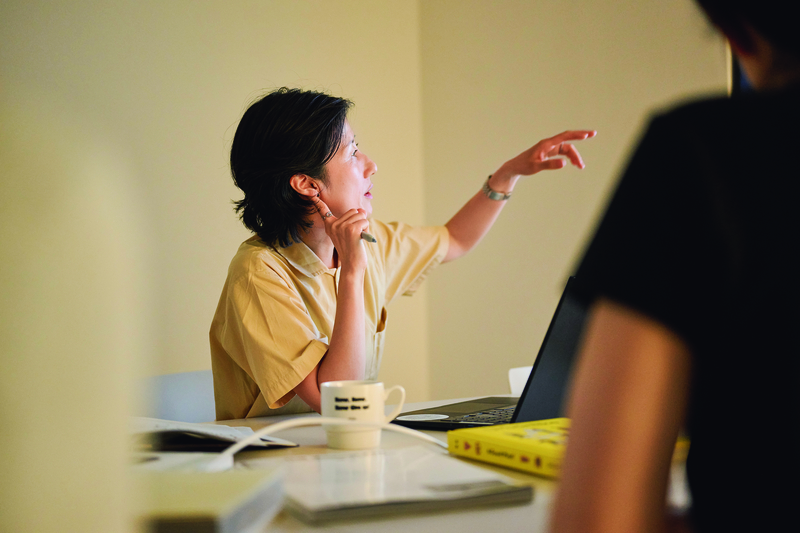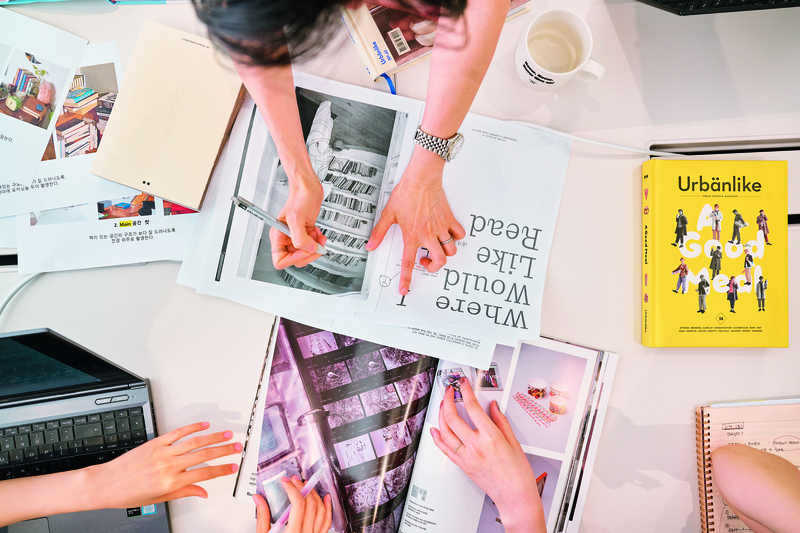Magazine editor-in-chief Kim Tae-kyung is always faced with nearing deadlines. She never stops thinking about how to improve operations but keeps an eye on a healthy work-life balance, not allowing work to consume her.

Kim Tae-kyung is the creator and editor-in-chief of Urbänlike, a magazine that focuses on city lifestyle and fashion.
Kim Tae-kyung regularly awakens well before dawn. In the first 30 minutes, she greets her dog, Bany; brushes her teeth; has lukewarm apple cider vinegar and probiotics; stretches; and meditates. Then she begins what she considers the most important part of her predawn routine: reflecting on the events of the previous day, setting goals for the new one, and submitting her thoughts to her journal.
This routine took shape about five years ago, when she was a night owl, going to bed and waking up late. Her health was deteriorating, so she decided to try being an early riser. “My quality of life changed, and everything felt somehow richer,” she recalls.
After breakfast—a sliced apple with peanut butter, two boiled eggs, one tomato, and either nut or almond soy milk—Kim is ready to begin her tasks as editor-in-chief of Urbänlike, a self-described “urban archive magazine” that she founded in 2013.
BREAKING THE MOLDS

Each issue of Urbänlike covers a single topic. The magazine is published only twice a year, making each issue more of a keepsake than a monthly publication.
Kim’s publication is an outlier. Technically a magazine, Urbänlike is more like a “mook.” Outwardly, it resembles a magazine, but it is intended to have the shelf life of a book, as it is only published twice a year. The volume and size of each issue, and even the paper type used for printing, change in accordance with the theme. Consequently, even past issues of the magazine generate steady sales, like popular books.
Kim is a nonconformist in terms of how she manages herself and steers operations. She goes to her Seoul office only four days a week and limits herself to working six or seven hours. She simply believes that one’s ability to fully concentrate diminishes after that. By around 4 p.m., Kim is gone.
Although Kim says that she does not push herself too hard—“I don’t pour my all into it”—she commits many hours to her job. “If I divide up my week, I’m working on my body for four days to get productive results, and on the mental part, where I’m inspired or studying, for three days,” she says.
An office day starts with listening to a music playlist that suits her mood. Then she organizes her schedule and catches up with email, the news, and social media to take the pulse of trends. The most time-consuming task is giving directions regarding the content of each issue. Since the writers are not at the office, communication is done remotely or via email.
LUCKY BREAK

The number of pages, size, paper type, cover design, and feel are different for every issue, and determined by its theme. This is why, no matter how many magazines Kim produces, the process feels new every time
It was in her first year of college when Kim took her first step into the world of magazines, assisting veteran reporters and working on street fashion pieces of her own. In 1998, her senior year, the Asian financial crisis triggered layoffs and dashed hopes of new college graduates. Nevertheless, Kim beat the odds. A magazine job offer came her way, and she jumped at it, forgoing her real dream of becoming a TV producer. “Of course, I had no idea at the time that I would end up staying.”
Numerous magazine gigs followed until 2009, when Kim went to Urban Books, a publishing group focusing on urban lifestyle. Four years later, she launched Urbänlike, entering the market for monthly magazines. The focus was on urban fashion and lifestyle. But by 2016, Kim wanted to escape the monthly deadlines and decided to adopt a format she had conceived in her first year in college: publishing only twice a year and focusing on one topic per issue. “I think my idea was: ‘What can I actually do?’ The only way forward was the collectible. Selectivity plus focus was the answer,” she says.
The switch removed the intensity of monthly deadlines and fit the reality of declining magazine sales and advertisers transitioning to websites. Readers appreciated the innovative concept, validating the decision to change. Past topics include “Hotel,” “Work from Home,” “Publishing House,” “Stationery,” “Dining,” and “Bowls.”
LOOSE STRUCTURE
Constantly reevaluating her day-to-day routine, Kim began to reorganize work even before the COVID-19 pandemic upended office life. “It felt as though I was monitoring all the reporters at their desks, and coming into the office every day just didn’t seem efficient. None of these things were aligned with the reasons I d the company in the first place, so I shut it down,” she explains.
Now, she hires freelance specialists instead of having permanent staff who may not always be suited to a particular topic. “This means I don’t have to spend energy on navigating interpersonal issues, so I can just concentrate on work.”
Last year, she hired two assistants, freeing up more of her time to focus on planning and design. “I’m not a particularly good writer or interviewer, and I don’t necessarily have a ton of knowledge, either; I’m kind of middling on all fronts,” Kim admits. “For a while, I worried that I really needed to be an expert on everything. But then I realized that I just need to find people who are good at what they do and let them do it, just like I don’t need to make bowls myself to publish a book about bowls.”
Project editors change with each issue, but aside from Kim, one specific photographer and two designers are permanent team members. They have been with her for a full decade now and shared her vision from the beginning. Along the way, the identity of Urbänlike has become clearer than ever.
“I thought that planning each issue needed to be done as a group, together with my colleagues. Then again, I’m the one who determines the brand identity. Because in the end, it goes in the direction I want it to go. So once the theme is chosen, I receive detailed proposals built around it and hand out different roles.”
FLUID ROUTINE
Besides shepherding her staff, Kim devotes large chunks of time to thinking about potential themes of future issues. “The most effective way is to travel to another city, because it allows you to ively see the content you want to , when you are one step away from your daily life. Of course, I am also inspired by other factors but they are just influencing me to a certain degree, and the most important thing is my own vision,” Kim says.
Every summer and winter, Kim works in different cities. “No matter where I am, I just need my laptop and I am all set. I try to maintain a state where I can stop working at any time.”
That is another way of her saying: “I will never settle and am always ready to change.” There are also times when you stop and ask yourself, “Why am I still doing this, and how should I proceed?” “Back when I worked for other magazines, the pressure was just too much sometimes. I think that is why, ever since I started working on my own projects, I have been trying to take better care of myself so that I don’t burn out,” Kim says.
“I think anxiety is an inevitable aspect of modern society. Such feelings are natural, but I try to think positively and not to let them overwhelm me. I don’t think about past regrets or try to predict the future. If I stay focused on the present and try to do my best in this moment, I think I will achieve my goals in the end.”
NEW GOALS
Kim wants to take Urbänlike to foreign markets. That has spurred her presence at international book fairs. She is also thinking a lot about bookmaking itself.
“Making a book is much more difficult and complicated than making a cup, but the cost-performance ratio is much higher for a cup. I need to find a truly efficient way to do the work, and I also want my business to succeed. I don’t think the magazine industry’s heyday will return, but I want to find something else. This sort of thing is always on my mind, because when I find myself saying, ‘I’m bored of this too now,’ or ‘This feels the same as everything else,’ I want to be able to transform without hesitation.”
Kim’s next goal is toa library similar to one that she visited in Helsinki, Finland. “There were kids on skateboards and some people lying on the grass, reading, and the whole place felt like a fun, sensory space, like a playground. I want toa space like that. I buy tons of books whenever I travel, but what is the point of keeping them for myself? I want toa library like that close to Seoul and live as a library grandma, like the volunteer senior citizens I saw at that library in Helsinki.”
Urbänlike was conceived around the question, “How can we eat well and live well in the city?”
“What I am aiming for is something in the middle. I think there is a lack of concern for the middle class, and there isn’t much content for them about the fundamental things in life. People in the middle don’t have a voice, and they don’t have much choice, so I’m trying to fill that void.”
Filling in the middle can be a good way to live in the city. Every day at dawn, in the solitude of her own time, Kim is getting closer to reaching this goal. For herself, and in her own way.
Hwang Kyung-shin Writer
Han Jung-hyun Photographer